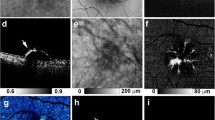Abstract
Purpose To report the changes seen in the retinal pigment epithelium (RPE) morphology in the asymptomatic eyes of patients with idiopathic central serous chorioretinopathy (ICSC) using spectral-domain Cirrus TM high-definition optical coherence tomography (HD-OCT). Methods In a prospective case series, 17 consecutive patients with unilateral ICSC underwent spectral-domain Cirrus TM HD-OCT scans for both affected and opposite asymptomatic eye. Three-dimensional single-layer RPE map was studied in both eyes for morphological alterations, and findings were correlated with clinical presentation, fluorescein angiogram, and 5 Line raster scan. Additionally, three-dimensional (3D) single-layer RPE maps done in 111 healthy volunteers served as control. Results In patients with ICSC, 3D single-layer RPE analysis of asymptomatic eyes showed presence of RPE bumps in 16 (94%) eyes and pigment epithelium detachment (PED) in 2 (11.8%) eyes. The 5 Line raster scan was normal in all eyes. Of 222 normal (control) scans, 18 showed RPE bumps and none showed PED. Conclusions 3D single-layer RPE map showed abnormal pattern in the asymptomatic eyes of patients with unilateral ICSC. Summary Spectral-domain optical coherence tomography showed morphologic alterations in retinal pigment epithelium in both eyes of patients with idiopathic central serous chorioretinopathy.






Similar content being viewed by others
References
Yannuzzi LA, Schatz H, Gitter KA (1979) Central serous chorioretinopathy. The Macula: a comprehensive text and atlas. Williams & Wilkins, Baltimore, pp 145–165
Gilbert CM, Owens SL, Smith PD, Fine SL (1984) Long-term follow-up of central serous chorioretinopathy. Br J Ophthalmol 68:815–820
Castro-Correia J, Coutinho MF, Rosas V, Maia J (1992) Long-term follow-up of central serous chorioretinopathy in 150 patients. Doc Ophthalmol 81:379–386
Bujarborua D, Chatterjee S, Choudhary A et al (2005) Fluorescein angiographic features of asymptomatic eyes in central serous chorioretinopathy. Retina 25:422–429
Marmor MF, Tan F (1999) Central serous chorioretinopathy: bilateral multifocal electroretinographic abnormalities. Arch Ophthalmol 117:184–188
Chappelow AV, Marmor MF (2000) Multifocal electroretinogram abnormalities persist following resolution of central serous chorioretinopathy. Arch Ophthalmol 118:1211–1215
Guyer DR, Yannuzzi LA, Slakter JS et al (1994) Digital indocyanine green video angiography of central serous chorioretinopathy. Arch Ophthalmol 112:1057–1062
Piccolino FC, Borgia L, Zinicola E et al (1995) Indocyanine green angiographic findings in central serous chorioretinopathy. Eye 9:324–332
Prunte C, Flammer AJ (1996) Choroidal capillary and venous congestion in central serous chorioretinopathy. Am J Ophthalmol 121:26–34
Sawa T, Gomi F, Tano Y (2005) Three-dimensional optical coherence tomographic findings of idiopathic multiple serous retinal pigment epithelial detachment. Arch Ophthalmol 123:122–123
Iida T, Hagimura N, Sato T, Kishi S (2000) Evaluation of central serous chorioretinopathy with optical coherence tomography. Am J Ophthalmol 129:16–20
Montero JA, Ruiz-Moreno JM (2005) Optical coherence tomography characterization of idiopathic central serous chorioretinopathy. Br J Ophthalmol 89:562–564
Gupta V, Gupta A, Dogra MR (2006) Atlas: optical coherence tomography of macular diseases and glaucoma, 2nd edn. Jaypee Brs Med Publishers (P) Ltd, N. Delhi, India, pp 72–103
Mitarai K, Gomi F, Tano Y (2006) Three-dimensional optical coherence tomographic findings in central serous chorioretinopathy. Graefe’s Arch Clin Exp Ophthalmol 244:1415–1420
Hirami Y, Tsujikawa A, Sasahara M et al (2007) Alterations of retinal pigment epithelium in central serous chorioretinopathy. Clin Experiment Ophthalmol 35:225–230
Garg SP, Dada T, Talwar D, Biswas NR (1997) Endogenous cortisol profile in patients with central serous chorioretinopathy. Br J Ophthalmol 81:962–964
Bouzas EA, Scott MH, Mastorakos G et al (1993) Central serous chorioretinopathy in endogenous hypercortisolism. Arch Ophthalmol 111:1229–1233
Gelber GS, Schatz H (1987) Loss of vision due to central serous chorioretinopathy following psychological stress. Am J Psychiatry 144:46–50
Jampol LM, Weinreb R, Yannuzzi L (2002) Involvement of corticosteroids and catecholamines in the pathogenesis of central serous chorioretinopathy: a rationale for new treatment strategies. Ophthalmology 109:1765–1766
Sunness JS, Haller JA, Fine SL (1993) Central serous chorioretinopathy and pregnancy. Arch Ophthalmol 111:360–364
Khng CG, Yap EY, Au-Eong KG, Liim TH, Leong KH (2000) Central serous retinopathy complicating systemic lupus erythematosus: a case series. Clin Experiment Ophthalmol 28(4):309–313
Maaranen TH, Tuppurainen KT, Mantyjarvi MI (2000) Color vision defects after central serous chorioretinopathy. Retina 20:633–637
Spaide RF, Hall L, Haas A et al (1996) Indocyanine green videoangiography of older patients with central serous chorioretinopathy. Retina 16:203–213
Guyer DR (1997). Central serous chorioretinopathy. In: Flower RW, Yannuzzi LA, Slakter JS (eds) Indocyanine green angiography. Mosby, St. Louis, pp 297–304
Shiraki K, Moriwaki M, Matsumoto M et al (1998) Long-term follow-up of severe central serous chorioretinopathy using indocyanine green angiography. Int Ophthalmol 21:245–253
Iida T, Kishi S, Hagimura N, Shimizu K (1999) Persistent and bilateral choroidal vascular abnormalities in central serous chorioretinopathy. Retina 19:508–512
Marmor MF, Yao X-Y (1994) Conditions necessary for the formation of serous detachment. Experimental evidence from the cat. Arch Ophthalmol 112:830–838
Spaide RF, Campeas H, Hall L et al (1996) Central serous chorioretinopathy in younger and older adults. Ophthalmology 103:2070–2079
Author information
Authors and Affiliations
Corresponding author
Rights and permissions
About this article
Cite this article
Gupta, P., Gupta, V., Dogra, M.R. et al. Morphological changes in the retinal pigment epithelium on spectral-domain OCT in the unaffected eyes with idiopathic central serous chorioretinopathy. Int Ophthalmol 30, 175–181 (2010). https://doi.org/10.1007/s10792-009-9302-2
Received:
Accepted:
Published:
Issue Date:
DOI: https://doi.org/10.1007/s10792-009-9302-2




